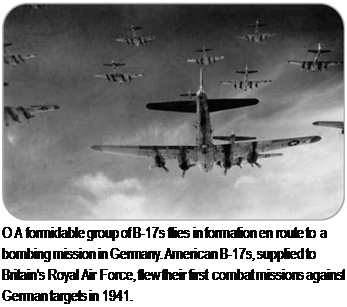Air Attack on Britain
In the summer of 1940, the German Luftwaffe launched an air assault on Britain. The German high command planned to destroy British air bases before an actual invasion or (they hoped) a British surrender. The plan failed, thanks to the resistance of RAF fighter pilots, a group that included Canadians, Australians, Poles, and American volunteers as well as British pilots. Many were just teenagers with only a few weeks’ training.
 The Battle of Britain was the first Allied air victory of the war. The Allies owed their success to a new invention: a top-secret radar system that gave early warning of the approaching enemy bombers. The British also had two modern fighter planes. The Hurricane, first flown in 1935 and designed by Sydney Camm (1893-1966), was used to attack German bombers, while the faster Spitfire tackled the German fighter escorts. The Spitfire (first flown in 1936) became one of the most famous airplanes of the war. Designed by Reginald J. Mitchell (1895-1937), it remained in service until the 1950s.
The Battle of Britain was the first Allied air victory of the war. The Allies owed their success to a new invention: a top-secret radar system that gave early warning of the approaching enemy bombers. The British also had two modern fighter planes. The Hurricane, first flown in 1935 and designed by Sydney Camm (1893-1966), was used to attack German bombers, while the faster Spitfire tackled the German fighter escorts. The Spitfire (first flown in 1936) became one of the most famous airplanes of the war. Designed by Reginald J. Mitchell (1895-1937), it remained in service until the 1950s.










